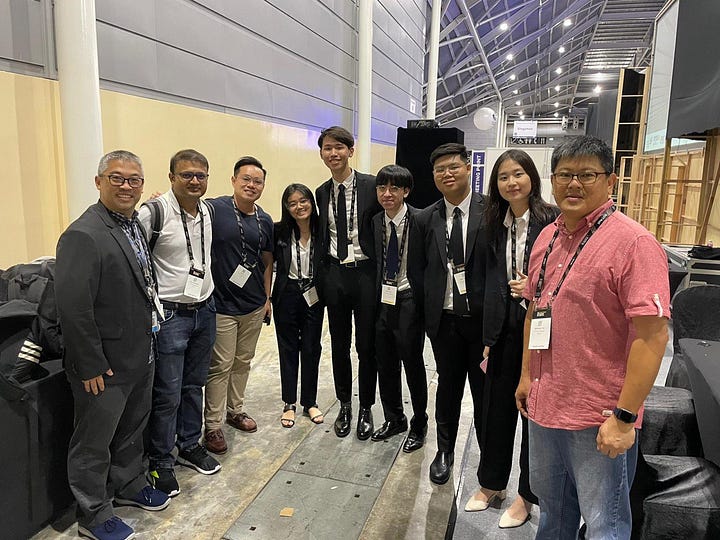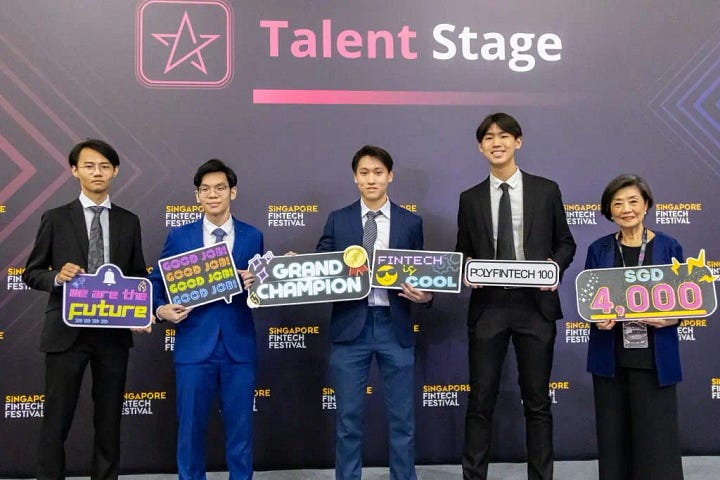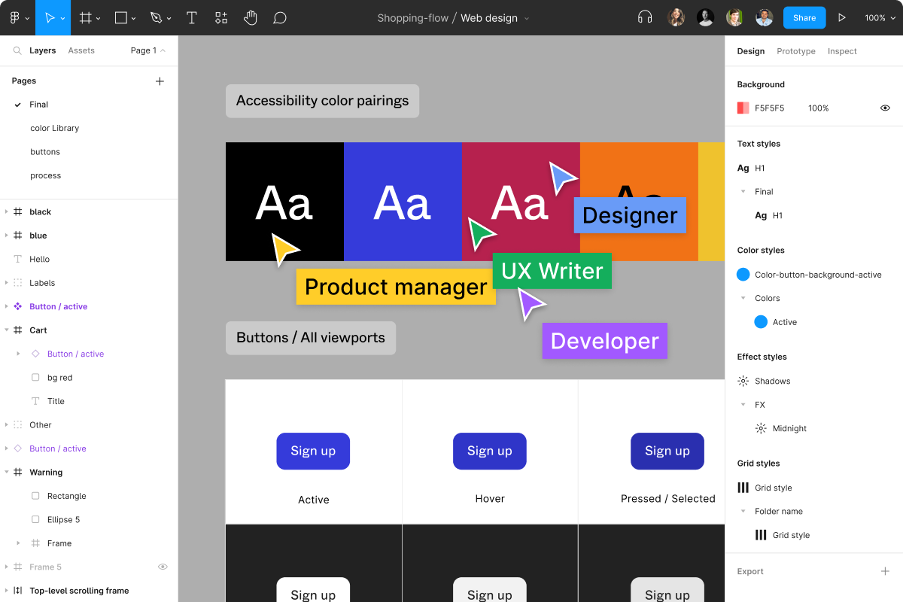Back-to-Back Champion: My Grand Finals Journey for PolyFintech100 API Hackathon at Singapore Fintech Festival
People remember story, learn to tell a good one.
One year ago at this very moment, my team won the grand champions for the PolyFintech100 API Hackathon.
Back then, I met one of my teammates in Ngee Ann Polytechnic's Personalized Learning Pathway "Startup Immersion Project (SIP)".
When two visionary people were on the same team and constantly pushed each other to be at our best, we knew we could make great things happen. Therefore, we formed an interdisciplinary team to join the hackathon.
We expected nothing much – we just wanted to gain experience in the Fintech world.
That initial goal, simple as it was, led us to winning the grand champion title.
This year, it happened all over again – except this time, I flew back to Singapore from Shanghai (currently having my internship there) for three days to attend the demo day.
As a two-time grand champion of the PolyFintech100 API Hackathon (in 2022 and 2023), I felt I had the responsibility to share what I've learned throughout these two years. My journey wasn't just about developing a Proof-of-Concept, prototyping, or preparing for the pitch. It was also about teamwork, learning from mistakes, and adapting to new challenges along the way.
This might sound cliché but it's the truth.
The grand stage at the Singapore Fintech Festival wasn't just a platform for competition, it was where ideas were forged and visions came to life.
Standing on that very stage again, I felt a literal sense of déjà vu, coupled with the excitement of pitching our idea and the possibility of creating something truly remarkable.
In this letter, I'll share some tips and advice based on what I've tried and tested – strategies that have worked well for me. I'll try to keep this as short as possible, but every word is a distillation of my experiences, a blend of hard-earned wisdom and insights gained from both victories and setbacks.
I believe it's not just about winning; it's about the journey, the lessons learned, and the stories we create along the way. With that in mind, let's dive in.
You must have a deep understanding of the rules of the game
At the start, it's all about understanding the rules of the hackathon.
Familiarize yourself with the requirements and judging criteria, and take note of the timeline you have to prepare for your prototype and pitch.
Also, study the sponsors, and understand why they came up with the problem statements. This will help you come up with creative and innovative ideas much more easily.
It Is crucial who you're working with – pick a committed team


When building a team, I've learned the immense value of diversity. It's not just about gathering people with different skills, but also about bringing together individuals with varied backgrounds and interests – for this hackathon, any interests related to Fintech would be helpful.
This approach has been a game-changer, particularly in tackling complex challenges like the problem statements given in the hackathon. Each unique perspective will add depth to your problem-solving strategies, significantly increasing your chances of winning.
Working alongside people from diverse backgrounds has introduced me to the power of diverse thinking. In Fintech, where trends shift rapidly and staying updated is non-negotiable, having a team that can swiftly adapt and bring fresh, innovative ideas to the table is invaluable.
The Preparation
I won't go into the specifics to bore you. But generally, here are some key tips to prepare for the hackathon:
1. Keeping up with the Fintech/Tech news
Subscribe to specialized newsletters and podcasts that focus on Fintech and Tech trends – such as PYMNTS.com, Fintech News SG Bankless, The Rundown AI, The Information, etc.
Follow key thought leaders in the industry on social media platforms like LinkedIn and X – such as @jason, @blader, etc.
Attend webinars, online conferences, and workshops to stay abreast of the latest developments – you can find some on Eventbrite (I attended some during my internship in Shanghai)
2. The little details matter
Pay close attention to the nuances in data and reports; sometimes, the smallest detail can have a significant impact
Develop a habit of double-checking your work for accuracy and completeness – make sure there's font and color consistency, and no grammatical errors
3. Put in the hard work, understand complex theories and diagrams
Dedicate time to study and dissect complex theories and diagrams. Break them down into smaller, more manageable parts – read whitepapers, news, articles, and anything that relates to the problem you're solving
Practice explaining these concepts in simpler terms, as if teaching someone else, to deepen your understanding – crucial for Q&A
Use tools like mind mapping or flowcharts to organize and comprehend complex information visually
Iterate, iterate, iterate
Rehearse, rehearse, and rehearse
4. Consult with industry experts and build connections along the way
Be open with your ideas and seek help from experts in that field (decreasing your time to learn a concept)
5. Tell people your idea and let them critique it
Share your ideas with colleagues, mentors, or a trusted group to get different perspectives (even if they don't know anything about the tech you're using, they are valuable sources of feedback – they might bring their expertise in other fields to complement your idea)
Be open to constructive criticism and use it as a learning opportunity to refine your ideas
The Demo Day
1. Focus on yourself
Don't worry about what the other teams have prepared, focus on yourself and your team
Get the pitch done just like how you did in your rehearsals
2. Give handouts (Principle of Reciprocity)
Prepare a set of documents that you think will be useful for the judges/audiences to have, print them out, and hand them to them before the pitch
In 2022, my team handed a well-prepared FAQ to answer potential queries that came to mind during our pitch
In 2023, we handed a deck of slides because some parts are quite technical and require time to look at them to understand
3. It's about how you sell it (Emphasize important words)
Focus on the language and tone you use in your pitch; persuasive and confident language can significantly impact your audience – keep in mind the six persuasion techniques by Robert Cialdini
Use storytelling techniques to make your presentation more engaging and memorable
Be prepared to adapt your speaking style based on the audience's reactions and engagement during the presentation
That's not all. The thing that sets us apart from others is our storytelling. And here's what I know and implemented, and what you should do too.
The Power of Storytelling
Good stories surprise us. They make us think and feel. They stick in our minds and help us remember ideas and concepts in a way that a PowerPoint crammed with bar graphs never can. — Joe Lazauskas and Shane Snow, The Storytelling Edge
Telling compelling stories to sell products and ideas is nothing new.
But it's this incredible, timeless way we share messages, stir up emotions, and connect with others, all wrapped up in a neat little narrative package. It's pretty much how we, as humans, make sense of this wild world and bond with each other.
Apply the same concept to your pitch deck.
Here's how my team structure it:
The secrets
Start the Narrative by Painting a Big Problem: Share the problem you're tackling – setting the scene for what's coming
Agitate the Problem and Make it Real: Get into how widespread the problem is and how it can affect a large population (to tell them why they should care)
The Team: Next, introduce the team (add logos of established companies to increase credibility – make sure to seek permission first before putting them in your deck). It's to get the audiences' buy-in and convince them that you're a credible and reliable team – and that they can count on you to solve this problem.
Introduce the Big Idea: Now, it's time to roll out the big solution to solve that problem
Show Off What Makes You Special: Talk about what's cool and different about your solution – what makes you stand out (remember the rule of 3, so share the top 3 USPs – make sure your audience can remember them easily)
Explain the Business Model: Here's where you dive into how you'll make money from this idea
Tell Them How You're Going To Do It: Share the roadmap of how you're going to make this happen
Share the Costs Needed to Get Your Project Off the Ground: Mention how much it'll cost, but keep it realistic – make sure it's a reasonable amount for an MVP
Close the Story: Finally, loop back to the problem and summarize how your solution is the answer everyone's been looking for
Finally, positioning is key
It really comes down to how you position yourself and connect with your audience.
For my team, we keep things simple, avoiding technical terms that might confuse them. A tip here is to have someone who knows nothing about your idea to listen to your pitch. If they can understand, it means the judges can understand.
Using clear, easy-to-understand language is what you should be aiming for. If the judges want more technical details, present your whitepaper beforehand, or dive in deeper during the Q&A session. This way, you make sure your message is clear and your audience is engaged throughout, and they are immersed in the story that you're telling.
Understand the difference between Central Route Processing Vs Peripheral Route Processing
A big point to remember is that people buy (get sold) with emotions and justify with logic. It has to do with something called “The Elaboration Likelihood Model”.
The Elaboration Likelihood Model taps into two routes of attitude change in humans:
The Central Route Processing: Using logic, reasoning, and deep thoughts/thinking
The Peripheral Route Processing: Using cues, imagery, and examples to elicit emotions
The central route encourages you to really think more critically about it – using your rational mind to consider the issues and arguments before reaching any decision.
Whereas the peripheral route encourages you to unconsciously focus on superficial images (or even examples that create an image in your mind) and “cues” in order to influence attitudes and decisions, without any serious consideration of the content.
Have a balance between the two for your pitch i.e. using imagery and examples, as well as useful data and tech jargons.
Ultimately, the key is to know who your audience is, and structure your pitch deck in a way that would allow them to understand. Some may be more technical (in this case you'll use more data and numbers), and some may not (in this case you'll use more imagery and analogy).
My Thoughts
It all builds up. And you'll know it if you've done it. At the grand finals or any pitches leading up to it, treat the pitches like normal conversations with the audience. The iterative rehearsals should already prepare you for them.
Most importantly, enjoy the moment, have fun with your teammates, and take this entire journey as a learning opportunity for you to grow.
Watch the PolyFintech100 API Hackathon 2023 Grand Finals and Category Finals video. Watch the PolyFintech100 API Hackathon 2022 Grand Finals and Category Finals video.
AI Tools to Boost Your Productivity
Fathom - Free app that records, transcribes, and summarizes video calls from platforms such as Zoom, Google Meet, or Microsoft Teams. Extremely useful for internal team and client meetings.
Taskade - With built-in AI content writer, video chat, mood boarding, mindmaps, and many more, this tool is perfect for marketers.
Tome AI - Save hours on design and never use default templates again. Build presentations simply via prompts.
Cognosys AI - Create AI agents that optimize over time. It's able to provide personalized AI agent services, data analysis, trend predictions, and personalized recommendations.
Superhuman AI - AI-powered email built for high-performing teams. It's compatible with Gmail and Outlook email accounts and is available for macOS, iPhone, iPad, and Chrome using a browser extension.acts as a search engine, providing accurate and informative answers in real-time.
In partnership with Figma
Brainstorm, design, and build better products – from start to finish with Figma
Whether it’s consolidating tools, simplifying workflows, or collaborating across teams and time zones, Figma makes the design process faster, more efficient, and fun—all while keeping everyone on the same page.
Personally I used Figma daily to create my creatives and prototypes, and has been a game changer in my design process. Figma's intuitive interface and collaborative features have significantly streamlined my workflow. Try it out if you haven't.
Top Learnings of the Week
AI and the Future of Law: The 10 Year ‘Overnight’ Success Story: This episode discusses the journey of Casetext, a company that started in 2013 as a crowdsourced law library. Over a decade, Casetext evolved into a significant player in AI, simplifying weeks of legal work into mere hours or minutes. Recently, it was acquired for $650 million. The episode features YC President Garry Tan and Casetext co-founder Jake Heller, who share insights into the company's origin, evolution, and the pivotal moments that led to its success (link)


